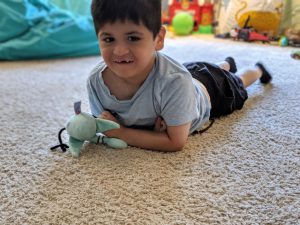 Every once and awhile you stumble upon a book that seems to magically connect with a particular student in a way that you could not predict. A friend had given me a massive box of hand-me-down books, and inside I found the wordless book, Wonder Bear. It was not a book I was familiar with, but since I’ve had such success with wordless picture books I decided to try it with Joey. I thought it would give us many opportunities to talk and describe the pictures, but I had no idea it would engage Joey as much as it did.
Every once and awhile you stumble upon a book that seems to magically connect with a particular student in a way that you could not predict. A friend had given me a massive box of hand-me-down books, and inside I found the wordless book, Wonder Bear. It was not a book I was familiar with, but since I’ve had such success with wordless picture books I decided to try it with Joey. I thought it would give us many opportunities to talk and describe the pictures, but I had no idea it would engage Joey as much as it did.
This Book Is Magic (Great Read Aloud Recommendation!)
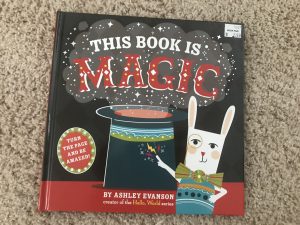 Joey and I recently enjoyed a few weeks of reading This Book is Magic by Ashley Evanson. Much like the books Push Here by Herve Tullet, This Book is Magic encourages the reader to fully interact with the book – tapping the page, waving or twirling fingers in the air, and saying magic words in order to make magic be revealed when you turn the page.
Joey and I recently enjoyed a few weeks of reading This Book is Magic by Ashley Evanson. Much like the books Push Here by Herve Tullet, This Book is Magic encourages the reader to fully interact with the book – tapping the page, waving or twirling fingers in the air, and saying magic words in order to make magic be revealed when you turn the page.
“Wiggle your fingers and say bravo!”
“Wave your magic finger and say Bippity Boppity Big”
Throughout the book the reader is able to turn a frog into a prince, make books large, cause a boat to disappear, and interact with a lion.
Exploring Chapter Books
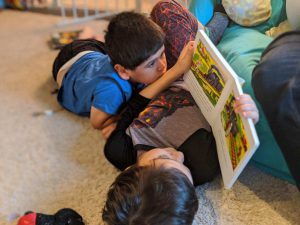 After spending four months with my own rising first grader I feel even more acutely aware of what rising first graders are into – and need to remember to bring age appropriate materials to Joey. My daughter loves the Princess in Black and the Mercy Watson books – both are series of simple chapter books with bright pictures on each page. They are the perfect bridge to reading chapter books – supporting the young listener (or reader) with entertaining and action-filled pages along with the illustrations.
After spending four months with my own rising first grader I feel even more acutely aware of what rising first graders are into – and need to remember to bring age appropriate materials to Joey. My daughter loves the Princess in Black and the Mercy Watson books – both are series of simple chapter books with bright pictures on each page. They are the perfect bridge to reading chapter books – supporting the young listener (or reader) with entertaining and action-filled pages along with the illustrations.
So, in my quest of always offering Joey age-appropriate materials, I brought a Mercy Watson book to his house.
The Day You Begin: Another great book for all types of diversity
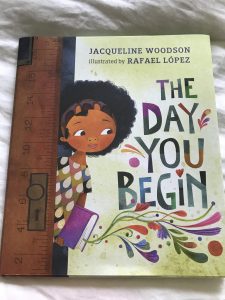 In my virtual Friday read aloud group that Joey participates in I read the book “The Day You Begin” by Jacqueline Woodson. It’s a beautiful book – in both the poetry of the words as well as the pictures. As an adult, I’d read it to myself when it arrived from Amazon and thought “This is perfect.” Of course, reading it silently to your adult self in your head is very different than reading it aloud to a group of energetic kindergarten and first graders on a hot June afternoon. Sometimes beauty gets lost in those moments.
In my virtual Friday read aloud group that Joey participates in I read the book “The Day You Begin” by Jacqueline Woodson. It’s a beautiful book – in both the poetry of the words as well as the pictures. As an adult, I’d read it to myself when it arrived from Amazon and thought “This is perfect.” Of course, reading it silently to your adult self in your head is very different than reading it aloud to a group of energetic kindergarten and first graders on a hot June afternoon. Sometimes beauty gets lost in those moments.
And yet – Joey surprised me. He appeared attentive and alert throughout the story. Of course, it is always hard to tell over zoom, but over the last few months I’ve become more adept at reading the body language of bored children through the computer screen.
Don’t forget to include all your learners in your important read-alouds
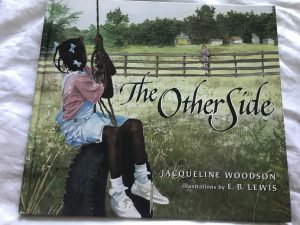 One of my favorite books to encourage children to discuss discrimination and racism is The Other Side by Jacqueline Woodson. Although I cannot meet with Joey in person yet, I found myself re-reading it with a view from how I would integrate it into my AAC work with Joey. It’s important for us to remember to share the same books and messages that we are reading and discussing with our typically developing students. The inability to engage in an oral conversation around an important topic does not mean we should shy away from it. Instead, we need to look into other ways to engage with all students.
One of my favorite books to encourage children to discuss discrimination and racism is The Other Side by Jacqueline Woodson. Although I cannot meet with Joey in person yet, I found myself re-reading it with a view from how I would integrate it into my AAC work with Joey. It’s important for us to remember to share the same books and messages that we are reading and discussing with our typically developing students. The inability to engage in an oral conversation around an important topic does not mean we should shy away from it. Instead, we need to look into other ways to engage with all students.
- 1
- 2
- 3
- 4
- Next Page »


